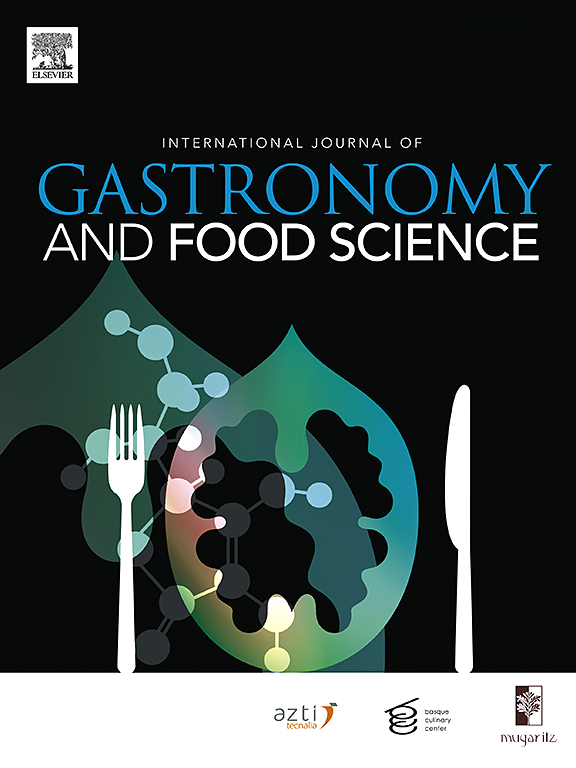Comparative investigation of the nutritional composition and flavor characteristics of pre-breeding diploid and triploid oysters (Crassostrea gigas) after steaming
IF 3.2
2区 农林科学
Q2 FOOD SCIENCE & TECHNOLOGY
International Journal of Gastronomy and Food Science
Pub Date : 2025-03-17
DOI:10.1016/j.ijgfs.2025.101167
引用次数: 0
Abstract
Steaming significantly altered the nutritional profile and flavor of oysters, with the extent of these changes influenced by the oyster's ploidy. This work aimed to investigate the variations in nutritional composition, texture and flavor compounds of diploid and triploid oysters after steaming using high-performance liquid chromatography and gas chromatography-ion mobility spectrometry. The results showed that steaming decreased the levels of aldehydes and ketones in oysters, including 2-methylbutanal-M (M means monomer) and 1-penten-2-ol. The calculated EUC values in steamed oysters (diploid: 6.89 ± 1.52, triploid: 11.20 ± 2.36) were significantly lower than those in untreated oysters (diploid: 11.71 ± 1.31, triploid: 14.85 ± 2.87). The inosine 5′-monophosphate and guanosine 5′-monophosphate contents in steamed triploid oysters were 45.45 % and 83.33 % higher than those in steamed diploid oysters, respectively. The highest contents of free amino acids were also detected in triploid oysters (1755.01 ± 175.83 mg/100 g). This study unveiled the alterations in nutrient composition, texture, and flavor characteristics of diploid and triploid oysters subsequent to steaming, thereby furnishing a robust scientific foundation for the optimization of oyster processing.
求助全文
约1分钟内获得全文
求助全文
来源期刊

International Journal of Gastronomy and Food Science
Social Sciences-Cultural Studies
CiteScore
5.30
自引率
10.50%
发文量
170
审稿时长
45 days
期刊介绍:
International Journal of Gastronomy and Food Science is a peer-reviewed journal that explicitly focuses on the interface of food science and gastronomy. Articles focusing only on food science will not be considered. This journal equally encourages both scientists and chefs to publish original scientific papers, review articles and original culinary works. We seek articles with clear evidence of this interaction. From a scientific perspective, this publication aims to become the home for research from the whole community of food science and gastronomy.
IJGFS explores all aspects related to the growing field of the interaction of gastronomy and food science, in areas such as food chemistry, food technology and culinary techniques, food microbiology, genetics, sensory science, neuroscience, psychology, culinary concepts, culinary trends, and gastronomic experience (all the elements that contribute to the appreciation and enjoyment of the meal. Also relevant is research on science-based educational programs in gastronomy, anthropology, gastronomic history and food sociology. All these areas of knowledge are crucial to gastronomy, as they contribute to a better understanding of this broad term and its practical implications for science and society.
 求助内容:
求助内容: 应助结果提醒方式:
应助结果提醒方式:


